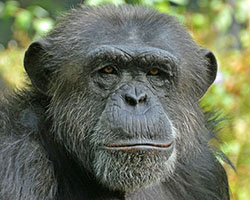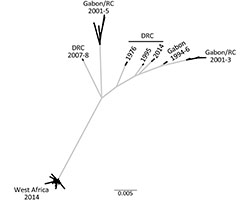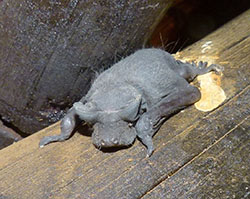
Tracking Ebola through Time
What's in the Story?

The virus enters your body through a bite you got while handling a monkey. It slips inside a host cell and hijacks the cell’s controls. The host cell suddenly begins making more and more viruses until the cell bursts open. Those new viruses then slip inside other cells, and the vicious cycle repeats.
More immune cells arrive to clean up the mess of dead cell parts. They try to clean up the viral infection as well, but the Ebola virus evades them. Eventually, the virus will infect most of the cells in your body, including the cells that make up your blood vessels. When these cells die, blood vessels become leaky. This causes internal bleeding, which can lead to multiple organ failure because the tissues in your body are not getting enough oxygen and nutrients. This is what leads to death in roughly 30 to 50% of patients infected with Ebola. Most patients start out with flu-like symptoms that worsen, and they die within the week.
How does the virus evade our immune systems so easily? Scientists compared the Ebola viruses involved in different outbreaks to learn how the virus evolves in the PLOS ONE article "New Perspectives on Ebola Virus Evolution."
How Does Ebola Invade a Host?
The deadly Ebola virus contains a single strand of genetic material called RNA. Each gene in the strand serves as a blueprint to make proteins, which embed onto the surface of the membrane. One of these is the glycoprotein gene. This gene codes for two membrane proteins: the spike glycoprotein and the secreted glycoprotein.

Like all viruses, Ebola needs to hijack a host cell in order to survive and replicate. The spike glycoprotein, a protein with an attached carbohydrate, helps the virus enter and infect host cells. The secreted glycoprotein acts as a decoy: it lures the immune system’s attention away from the spike glycoprotein. The immune system starts producing antibodies to fight the secreted glycoprotein, while the spike glycoprotein continues to sneak the virus into cells. Thus, the Ebola virus keeps the immune system guessing while the infection grows stronger.
Not All Animals are Equal
Since the mid-1970s, outbreaks of Ebola virus have erupted in human, chimpanzee, and gorilla populations in western African countries. However, there are long spans of time between outbreaks. During these lulls, the virus hides in reservoir species. Reservoirs are animals in which the Ebola virus can replicate enough to stay present, but not enough to make the animal sick. Scientists still do not know what the reservoir species for the Ebola virus are.
Not All Ebola Viruses are Equal
Since the discovery of Ebola, scientists have collected and stored information about glycoprotein genes from different virus outbreaks. They have noticed that not all glycoprotein genes are the same. How can this be?

When viruses replicate, they replicate and pass on copies of their genes to their “offspring.” During copying, mistakes can result in gene mutations. For example, imagine if you copy a tricky word such as “rhythm” a thousand times. Every so often, you will most likely make a spelling mistake and “mutate” the original word by adding, deleting, or switching one or two letters.
Differences between the glycoprotein genes most likely come from these random mutations. Mutations can change the amino acids that make up the glycoprotein, which leads to a change in the protein’s shape. For proteins, the shape determines what it can do. The spike glycoprotein is broken down into parts. One part is disordered, or unstructured, because its chemical composition cannot maintain structure. The other part is structured. Scientists compared the evolution of the glycoproteins to understand how these shapes may change over time and affect the survival of the virus.
Evolution of a Virus
Factors in the virus’ environment, such has the host immune system, will determine if the mutated gene is beneficial or not. If a mutation helps the Ebola virus survive longer and replicate faster, then the virus has experienced positive selection. If the mutation weakens the virus and the virus cannot replicate, then the virus has experienced purifying selection. Usually, with purifying selection, the mutated version of the gene dies out over time. Most mutations, however, do not affect the ability of the virus to survive and replicate. In these cases, we acknowledge that the gene has still changed over time due to genetic drift.
Tracking Genes with Phylogenetic Trees

Scientists compared the glycoprotein genes from Ebola viruses collected from different outbreaks. Researchers first downloaded the genetic information from online databases. They then constructed a phylogenetic tree to track how different parts of the glycoprotein genes had changed over time. By tracking these changes, scientists determined which parts of the glycoprotein genes had experienced positive or purifying selection, or have collected mutations that do not affect its survival.
Evolutionary Insights
Constructing the phylogenetic tree of different Ebola virus glycoprotein genes led to four main conclusions:
- The disordered region of the spike glycoprotein varies the most among Ebola viruses. This region has experienced a lot of genetic drift, but the overall function appears to have mostly stayed the same. This region also experienced some positive selection, which means that some mutants were able to survive better and reproduce more than others. In other words, the mutated disordered region may become better at hiding within the body over time. These results may explain how the Ebola virus has been able to escape the wrath of the immune system.
- The structured part of the spike glycoprotein is similar among Ebola viruses and has experienced purifying selection. These results imply that the structured part must keep its shape and function or the virus will die. It appears that the structured part of the spike glycoprotein does not need to change. The secreted glycoprotein may protect the structured part of the spike glycoprotein by acting as a decoy target for the immune system.
- Switching between different species of hosts may help drive the evolution of the glycoprotein gene. Between 2001 and 2005, the glycoprotein gene changed a lot. During this time, gorilla and chimpanzee populations suffered from Ebola virus outbreaks, and human cases were associated with the handling of diseased primates.
- The Ebola virus outbreaks between 1976 and 2014 apparently had multiple animal sources. However, scientists still do not know which species act as reservoirs for Ebola virus. Bats are likely suspects, but scientists need more data to conclude this.
What’s Next for Ebola Research?

Now that we know which parts of glycoproteins are most important for virus success, we need to understand how other species can affect the evolution of those proteins. Future works should focus on finding the reservoir species of the Ebola virus. By identifying the reservoir species, scientists may be able to understand how the virus changes between outbreaks and how it jumps from a reservoir to humans. Until then, it will be very difficult to predict and prevent the next Ebola virus outbreak.
EvMed Edits are sponsored by ASU's Center for Evolution and Medicine.
Additional images via Wikimedia Commons. Colored ebola virus particles by Thomas W. Geisbert; black and white ebola virus by the CDC.
Read more about: Tracking Ebola through Time
Bibliographic details:
- Article: Tracking Ebola through Time
- Author(s): Sisi Gao
- Publisher: Arizona State University School of Life Sciences Ask A Biologist
- Site name: ASU - Ask A Biologist
- Date published:
- Date accessed:
- Link: https://askabiologist.asu.edu/evmed-edit/ebola-evolution
APA Style
Sisi Gao. (). Tracking Ebola through Time. ASU - Ask A Biologist. Retrieved from https://askabiologist.asu.edu/evmed-edit/ebola-evolution
Chicago Manual of Style
Sisi Gao. "Tracking Ebola through Time". ASU - Ask A Biologist. . https://askabiologist.asu.edu/evmed-edit/ebola-evolution
Sisi Gao. "Tracking Ebola through Time". ASU - Ask A Biologist. . ASU - Ask A Biologist, Web. https://askabiologist.asu.edu/evmed-edit/ebola-evolution
MLA 2017 Style

The Ebola virus seems fairly simple - a single strand of RNA - but it sneaks into cells, such as those that make up the immune system, and starts replicating. Once the infection spreads, the Ebola virus causes an often-fatal disease.
Be Part of
Ask A Biologist
By volunteering, or simply sending us feedback on the site. Scientists, teachers, writers, illustrators, and translators are all important to the program. If you are interested in helping with the website we have a Volunteers page to get the process started.
